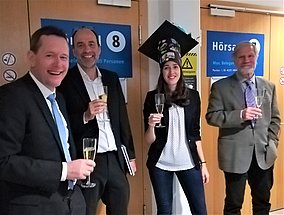


Supervisor: Gerhard Herndl
PhD student: Barbara Bayer
Defended on 11 April 2019
Ammonia-oxidizing archaea (AOA) are among the most ubiquitous and abundant microorganisms on Earth, especially in deep waters of the global ocean where they represent 20–40% of the prokaryotic community. AOA perform the first, rate-limiting step of nitrification, oxidizing ammonia (NH3) into nitrite (NO2), thereby generating energy for autotrophic growth. Hence, they represent key players in the nitrogen and carbon cycle. Thus, understanding their physiology is of great importance to understand the biogeochemical cycling of these elements in the global ocean. Nevertheless, the cultivation of AOA is challenging and only few axenic cultures are available, due to their comparably long generation times, low growth yields and their inability to grow on solid medium. This thesis aimed at investigating the physiology and ecological role of marine AOA using two novel marine isolates as model systems. Their metabolic traits, functional adaptations and potential environmental niches were characterized. Furthermore, their response towards oxidative stress and their metabolic interactions with heterotrophic bacteria were investigated. Both AOA strains were isolated from the Northern Adriatic Sea and although extremely closely related, they exhibited different metabolic traits and functional adaptations. These included the ability to use urea as alternative substrate for ammonia oxidation, and the potential for chemotaxis-driven motility. Such distinctive differences can lead to fine-scale ecological differentiation and consequently result in the occupation of different ecological niches. The physiology and genome-based characterization resulted in the description of two separate species designated Nitrosopumilus adriaticus NF5T and Nitrosopumilus piranensis D3CT. Further physiological studies revealed that neither strain was able to efficiently use leucine as a source of energy and/or carbon, indicating that they are obligate autotrophs. Moreover, all thus far described marine AOA strains lack the enzyme catalase to detoxify hydrogen peroxide (H2O2). The physiological status and molecular response of three Nitrosopumilus strains, N. adriaticus, N. piranensis und N. maritimus exposed to H2O2 was investigated using comparative proteomics. All three strains continuously produced H2O2 at relatively high levels during metabolic activity, ultimately inhibiting their growth. In addition, their proteome composition changed upon exposure to H2O2, including proteins putatively involved in remodeling of the extracellular matrix, which we hypothesize to be a strategy limiting the influx of H2O2 into the cells. In a co-culture system, the heterotrophic alphaproteobacterium Oceanicaulis alexandrii facilitated the growth of Nitrosopumilus spp. by scavenging H2O2, highlighting the significance of potential mutualistic interactions between typically free-living microbes in community-level stress response. Conversely, Nitrosopumilus spp. released organic compounds that supported the growth of O. alexandrii. Additonally, we could show that members of the Nitrosopumilus genus release ecologically and biochemically relevant metabolites, including B vitamins, amino acids and thymidine. This suggests that AOA might be important net producers of these compounds in the ocean, potentially supporting the growth of diverse microbes. Hence, metabolic interactions within the immediate surrounding of AOA cells could depict a successful ecological strategy for heterotrophic bacteria. Particularly in the aphotic layers of the ocean, where phytoplankton are inactive, chemolithoautotrophs might play a crucial role in generating dissolved organic matter and providing it as substrate for heterotrophic prokaryotes.
Please find a list of publications here.